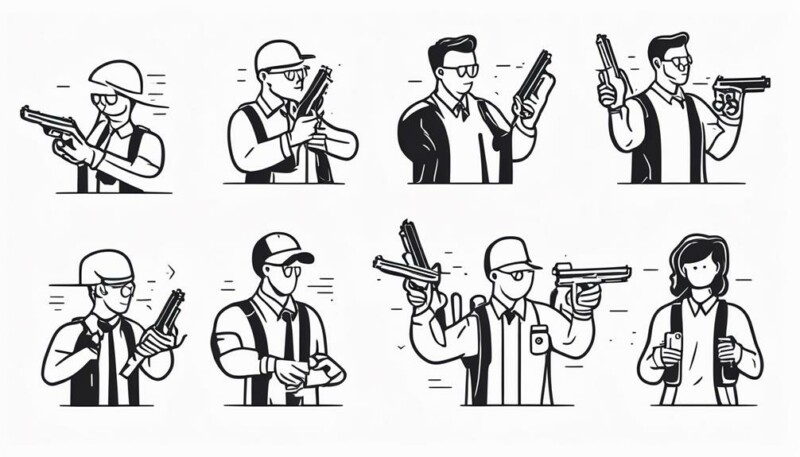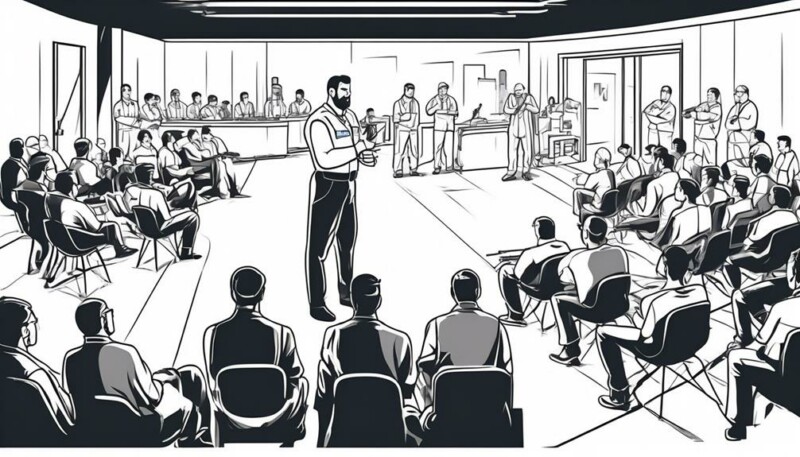Is it really true that knowledge of fundamental gun safety and firearm laws can mitigate the risks associated with firearm accidents and misuse?
You're about to embark on a journey to understand the ins and outs of responsible firearm ownership. We'll explore the essential gun safety rules, the legal aspects of carrying firearms, and the often-debated commandments of firearm safety.
You'll also get to know the subtle differences between concealed and open carry, and we'll touch upon some specific Texas and Federal firearm laws.
As we navigate through these potentially life-saving guidelines, you'll find yourself better equipped to handle firearms safely and responsibly, but there's one crucial aspect we haven't mentioned yet…
Key Takeaways
- Always treat every gun as if it's loaded, regardless of its actual condition.
- Store firearms responsibly, keeping them unloaded, locked, and separate from ammunition.
- Comply with concealed carry regulations and understand the specific requirements for permits and licensing in your state.
- Educate yourself and others about firearm safety, including safe handling practices and the importance of knowing your target and what lies beyond it.
NRA's Fundamental Gun Safety Rules

When handling firearms, the NRA emphasizes five fundamental safety rules: always point the gun in a safe direction, treat every gun as if it's loaded, keep your finger off the trigger until ready to shoot, be certain of your target and what lies beyond it, and ensure you know how to use the gun safely.
These basic principles form the backbone of Gun Safety, reflecting the mantra that safety ALWAYS comes first.
Understanding safe firearm handling isn't just about knowing these rules; it's about implementing them every time you handle a firearm. Firearms safety courses can help reinforce these principles, ensuring you're well versed in every aspect of gun safety.
Don't forget the importance of storage, either. Always store your firearm responsibly, ensuring it's out of reach of those who shouldn't have access to it. By reminding yourself of these basics of safe handling and storage, you help prevent potential accidents.
Legal Aspects of Firearm Carrying
Let's now turn our attention to the legal aspects of firearm carrying.
You need to understand that the law stipulates specific requirements for permits and licensing, along with rules for concealed carry.
It's critical to stay informed about these regulations to ensure you're legally carrying.
Permits and Licensing
Understanding the permits and licensing required for carrying firearms is crucial, as these regulations vary widely across different states and regions. For instance, under Texas law, a license to carry is mandated, which requires firearm education through safety courses. These courses cover safe handling, handling and storage, and emphasize safety when handling firearms.
Remember, firearm safety ALWAYS comes first. Safety on the safe handling and storage of firearms can save lives. It's vital to adhere to the rules of permits and licensing to avoid legal complications. They ensure you're accountable for your firearm and understand the gravity of its potential misuse.
Concealed Carry Regulations
Navigating the legal aspects of carrying a concealed firearm, it's crucial you're well-versed in your state's concealed carry regulations, including eligibility requirements, restrictions, and specific rules about carrying firearms in vehicles and public places. Understanding Basic Firearm laws and Rules of Firearms is a key aspect of safe gun handling.
Here's a brief table for quick reference:
| Key Terms | Description |
|---|---|
| Open carry | Permitting firearms to be visibly carried |
| Safe direction means | Handling firearms in a way that minimizes harm |
| Firearm safety | Safety procedures outlined for handling firearms |
Ten Commandments of Firearm Safety

As we explore the 'Ten Commandments of Firearm Safety', it's essential to remember that responsible gun handling is paramount.
You should be well-versed in firearm laws and always practice shooting etiquette.
Understanding and adhering to these principles can significantly enhance safety during firearm use.
Responsible Gun Handling
When handling firearms, you must always keep the weapon pointed in a safe direction, mindful of potential ricochets and penetration. Your firearm handling should always keep safety as the top priority. This includes treating every gun as if it's loaded, even if you're sure it's not. Always visually check for ammunition before shooting or passing it to someone else.
| Principle | Explanation |
|---|---|
| Safe Direction | Always point the firearm in a safe direction, conscious of ricochets and penetration |
| Check for Ammunition | Treat every firearm as if it's loaded and verify visually |
| Ready to Fire | Only place your finger on the trigger when you're ready to shoot |
Moreover, ensure proper storage of firearms and ammunition when not in use and always carry firearms safely, especially on the shooting range.
Understanding Firearm Laws
Delving into the 'Ten Commandments of Firearm Safety', you'll gain insight into the essential laws governing safe and responsible gun use. Understanding fundamental gun safety is the key to firearms use.
You should ALWAYS handle a firearm safely. This means never assuming a gun is unloaded and never pulling the trigger unless you're ready to shoot. Developing safe shooting habits, like ensuring your firearm is pointed in a safe direction and considering possible ricochets, is a core part of firearm laws.
Common sense dictates that you don't touch the trigger while loading or unloading, and always be aware of your target and what's beyond it. Remember, safety is paramount in the handling and usage of firearms.
Practicing Shooting Etiquette
Building on your understanding of firearm laws, let's now turn our focus to the crucial aspect of practicing shooting etiquette, more specifically, mastering the 'Ten Commandments of Firearm Safety'.
You must constantly stress safety while handling firearms. Here are four key principles:
- Finger Off the Trigger: Keep your fingers away from the trigger until ready to shoot. This minimizes accidental discharges.
- Sure of Your Target: Shotgun pellets can travel a great distance. Always know your target and what's beyond.
- Visually Check the Chamber: Always visually check the chamber when handling a firearm with the safety on.
- Closely Supervised When Handling: Beginners should be closely supervised when handling firearms to ensure safety.
Comprehensive Gun Safety Course

Taking a Comprehensive Gun Safety Course equips you with essential knowledge on firearm handling and direction, emphasizing the crucial rule of always keeping your firearm pointed in a safe direction. This understanding of fundamental gun safety is crucial whether you're at a shooting range or anywhere firearms might be present.
You'll be trained never to point the gun at anything you don't intend to shoot, and always to open the action and check the chamber when handling a firearm. These lessons are crucial to ensure everyone's safety. You'll also learn to avoid touching the trigger while loading or unloading, and to maintain a safe position or anywhere you're supervised when handling firearms.
The comprehensive gun safety course also underscores the importance of eye and ear protection. It stresses that every firearm should be treated as if it's loaded and to be aware of your surroundings, with a strong focus on what lies beyond your target.
Understanding Concealed Vs Open Carry
Navigating the nuances of concealed versus open carry laws can be a complex task, but it's vitally important to understand the differences and legalities in your specific area. Understanding fundamental gun safety is paramount, and the first step is understanding concealed vs open carry.
Concealed carry means hiding your firearm from plain view. It's often the choice for experienced gun owners who want to maintain a low profile.
Open carry, on the other hand, means your firearm is visible to others. It can be a strong deterrent but can also draw unwanted attention.
The firearm laws vary significantly by state and locality, so it's a habit to know exactly what your area's laws are.
Some places require permits for concealed carry, while others allow open carry without one.
A frequently asked question is about the high velocity cartridge. It's allowed in both open and concealed carry, but always remember never to put your finger on the trigger of any firearm until ready to shoot.
Whether you're at a range or shooting area, always stress safety when handling any firearm. In both cases, knowledge and responsible gun handling are your best defense.
Texas & Federal Firearm Laws

Diving into Texas and federal firearm laws, it's essential to know that they are both crucial in shaping the rights and responsibilities of gun owners in the state. Understanding fundamental gun safety is a prerequisite to comprehending these laws.
Texas & federal firearm laws dictate you should open the action immediately when handling a firearm. This is a safety measure to ensure the firearm is not loaded. You're also mandated to maintain control of the direction of your firearm – never point your gun at anything you don't intend to shoot.
Additionally, you're advised not to shoot unless you know your intended target or ricochets. Bullets can penetrate walls and other barriers, so being aware of your surroundings is critical. Remember, never handle a firearm until you actually intend to use it.
To aid your understanding, here's a simple table:
| Texas Law | Federal Law | |
|---|---|---|
| 1. Open Action Immediately | Yes | Yes |
| 2. Control of the Direction | Yes | Yes |
| 3. Know your Target and Ricochets | Yes | Yes |
| 4. Bullets Penetrate Walls | Yes | Yes |
| 5. Handle Firearm Only When Intended | Yes | Yes |
Being aware of these laws helps ensure safety and responsible gun usage.
Safe Firearm Storage With Children
While being fully aware of Texas and federal firearm laws is crucial, it's equally important to understand and implement safe firearm storage practices, especially when children are present in the home. Safe firearm storage with children isn't just a matter of law, it's also about safety and responsibility.
- Be aware that even when firearms aren't in use, they should be stored unloaded, locked and separate from ammunition. This is particularly important when loading or unloading the firearm.
- Use certain types of secure storage such as gun safes, lockboxes, or trigger locks for your firearms. The receiver and magazine should be inaccessible, especially to children.
- Always keep actions open while loading or unloading anywhere you handle the firearm. This is considered a mark of responsible firearm handling.
- Educate your children about firearm safety. Make them understand the potential dangers and that they should never touch a firearm without adult supervision.
Frequently Asked Questions
What Are the Fundamental Rules of Gun Safety?
You've got to remember four fundamental rules of gun safety.
First, always treat guns as if they're loaded.
Second, never point a gun at anything you don't intend to destroy.
Third, keep your finger off the trigger until you're ready to shoot.
Lastly, be sure of your target and what's beyond it.
Don't forget about wearing eye and ear protection, using the correct ammo, and storing firearms safely.
What Are the 4 Primary Rules of Firearm Safety?
The four primary rules of firearm safety you need to remember are:
- Treat every firearm as if it's loaded.
- Never point a firearm at anything you don't intend to shoot.
- Keep your finger off the trigger until you're ready to shoot.
- Be sure of your target and what's beyond it.
These rules aren't just guidelines, they're lifesaving principles. It's crucial you follow them every time you handle a firearm.
What Are the Four 4 Cardinal Rules of Gun Safety?
You're asking about the four cardinal rules of gun safety.
Firstly, always treat guns as if they're loaded.
Secondly, never point a gun at something you're not prepared to destroy.
Thirdly, keep your finger off the trigger until you're ready to shoot.
Lastly, be absolutely sure of your target and what's beyond it.
These rules are vital in ensuring both your safety and the safety of those around you.
Why Are Gun Safety Laws Important?
Gun safety laws are crucial because they protect you and others from unintentional harm. They enforce responsible firearm ownership and handling, reducing the risk of accidents.
Moreover, they prevent unauthorized individuals, like criminals or minors, from accessing guns. By adhering to these laws, you're fostering a culture of accountability and safety, ensuring weapons are used correctly and responsibly.
Understand these regulations; they're not just rules, they're safeguards for everyone's security.
Conclusion
In the end, remember, knowledge is power.
Understanding fundamental gun safety rules and firearm laws is essential. Whether it's the NRA's rules, the Ten Commandments of Firearm Safety, or the specifics of concealed versus open carry, being well-informed makes all the difference.
Always keep safety at the forefront, especially when children are involved. As the adage goes, 'an ounce of prevention is worth a pound of cure.'
Stay safe, stay informed, and respect the power of firearms.
